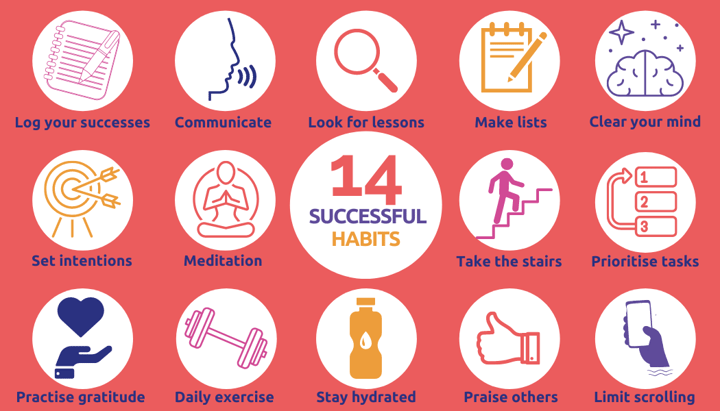[Leadership]
Leading with Impact: How to Lead Successful Teams

Unlock Your True Leadership Skills to Inspire High Performance Teams
Becoming a leader is a journey filled with learning, hard work and personal development. So what happens once you make it to the top? Indeed, being the boss can feel as frustrating and taxing as it does rewarding and fulfilling.
While from day to day we make sure we come across as in control; inside, we're still 100% human. Humans that others look to for guidance, leadership and motivation.
The daily life of a leader requires a lot of focus from the conscious mind; having to lead the charge, be creative, deal with the day-to-day, fight the fires, and still try to implement a positive strategy and change can easily consume our time and burn us out.
The greater challenge then comes from the need to keep the team continuously motivated and performing well, delivering the results the business needs. No one has an endless reserve of energy and inspiration to draw from, that’s a human truth.
However, there's a secret.
Every single one of us holds within the power to take control of the power of our subconscious minds, unleash our truest potential and show up every day competent, confident and full of character. With practice, we can transform our internal responses and our relationship with ourselves, and in doing so propel ourselves towards results that have impact, greater success and a happy balance between life and work.
Allow us to share some insights.
Learning to be a Leader
The beginning is a very good place to start.
When you became a manager, how did you feel? What did you anticipate would change versus what changed in reality? Were your expectations met? Did you find that the role you anticipated was not quite the role you got?
This is important because becoming a boss for the first time is an initiation, the challenges involved in this transition shapes your leadership style, and therefore affect the organisation as a whole.
Professor Linda A Hall of Harvard Business Review puts it this way;
“Let me emphasise that the struggles new managers face represent the norm, not the exception...One of the first things new managers discover is that their role, by definition a stretch assignment, is even more demanding than they anticipated.”
From an NLP perspective, the point here is this: experiences shape patterns of behaviour. For those who worked tirelessly for their place at the top, there are countless experiences (and some great stories) about what it took to get there.
At Life Ladder, as a part of our 7 Step Subconscious Catalyst System (7-SCS), we work with memories and behavioural patterns, and share techniques on our professional development journey that transform thought processes and re-wire responses and deliver improved results. These techniques not only maximise the performance of company bosses, but equip entire teams with the ability to lead and self-lead.
.png?width=720&name=qupote%20(800%20x%20200%20px).png)
As a result, you won’t have to go out of your way to stay on top of things, you won’t have to go out of your way to motivate others.
So, not only will you perform better than ever as a leader, but when it comes time to hand out a promotion, you know your people are ready to rise to the challenge.
Harnessing the power of the subconscious mind
It’s easy to take our brains for granted. It feels like we’re just getting on with things, without too much thought about the operating system underneath it all. The truth of the matter is, our brains require a huge amount of energy in order to operate and process fast and effectively. This is particularly true at work, where on a daily basis we use our conscious minds to remain focused, come up with creative ideas, look for solutions, manage people etc.
The brain copes with all this by being energy efficient. The mind divides input for either subconscious or conscious processing, in order to conserve the energy we use to think.
Here’s how it works:

It’s in the subconscious mind where we can embed unhelpful habits and attitudes that unwittingly stop us from achieving our goals, be it through how we approach tasks or how we interact with others.
But making genuine and permanent changes to deep-set behaviours takes a lot of time, energy, dedication and possibly even therapy, right?
Well, the short answer is no.
Most people attempt to tackle their habits, behaviours and attitudes using the conscious mind.
But by trying to force themselves to solve this logically, it's no match for your fundamental relationship with your subconscious programmes.


And if you asked him, he'd tell you he's after a promotion
So, how do you tap into the subconscious mind and better still, re-wire it?
In the cartoon above, one answer would be addressing habits. Habits can have more control over us than we care to admit, dragging us down, making us ineffective and taking us off course from achieving our goals. Sometimes, we know we need to change but we struggle because so many of our behaviours are on auto-pilot, led by engrained programming from experiences throughout our lives, stored in the subconscious mind.
Here are some examples of habits that help people achieve more:

Sometimes it might be habits that at first glance seem inconsequential but however small they are, they will help deliver the change you're looking for once you start learning how to make or break them (and we can show you how, in step by manageable step).
Habits are just one fundamental element of a wider system in the 7-SCS. Alongside it are values, identity, beliefs, memories, decisions and imagination.
Manage your time, manage your life
Time is precious. As a manager, it can sometimes feel that having any time to yourself is a bonus. So many accept that as part of their leadership role, the price of admission for being the boss, but it certainly doesn’t have to be that way.
Here’s a quick breakdown of how the average leader divides their time during the week:
.png?width=800&name=Education%20(2).png)
These are very easy patterns to fall into. Being reactionary is a huge sinkhole for time at work, and often results in the day-to-day work and self-development (and sometimes business improvement) priorities spill over to the weekend. It feels like you have to fight to get ahead, and improvements to the business as a whole (or yourself as a leader or person) are afforded little space to flourish.
Here’s an alternative picture:

That’s much better.
And now for the inevitable question: How do I develop myself to be an effective leader easily?
Enter, Life Ladder. Our platform and e-learning professional development journey keeps you focused on the priorities and helps you achieve your big to-dos. The techniques learnt allow you to free up space, and use subconscious programming to make leaders, and entire organisations, more efficient. Let’s say you want to make your sales force more self-sufficient and accountable, we help you develop the mindsets to do just that.
Some of examples of how Life Ladder helps develop powerful leadership skills:
1 - Focus on culture
- Creating a learning organisation, where all employees are working towards goals in the same way the leaders do
- Setting an example for wellbeing, where self-management and inner resources mean growth, happiness and success echo throughout the entire company.
2 - Imagination
- Identifying what’s a quick fix and what requires a long-term mindset
- Space to focus on the next 5 years as much as the next quarter
3 - Pursuit of perfection
- Learning, not knowing - growth mindset is key
- Improving yourself = improving the organisation
4 - Finding ease
- Removal of chaotic complexities
- Freeing up mental RAM
- Champion simplicity
- Ability to identify what isn’t adding value - what’s holding you back?
5 - Provides Clarity
- Ability to prioritise and make the decisions that tick off the big to-dos
- Clear and effective communication that builds strong relationships and brings out the best in the team
6 - Curious, present, aware
- Making a habit of being present in all areas of the organisation - not just during a crisis or when you want something.
- Making it your business to understand the roles of every employee, and how they can develop and surmount their challenges by tapping into all 7 of these subconscious catalysts (covered in the Life Ladder 7-Step Subconscious Catalyst System).
Curious about the 7-Step SCS? Life Ladder's Subconscious Catalyst System underpins our e learning personal and professional journey that helps people adopt the mindsets and behaviours that help them flourish both professionally and personally. In 7-SCS we've woven together fundamental principles of neuroscience, coaching, NLP, psychology and learning theory - not to mention developing the system through more than 150o case studies! The journey is delivered through bite-sized daily content, microlearning and real-world application that's designed to shift learning into long-term memory and create continuous change and development. The learnings create self-awareness, self-mastery and a mindset change that serves for more happiness and success. If you're curious, why not book a demo below to see it in action.
We’ll round off with a word from our Founder:
"The more you do this, the smarter your brain works. It creates a harmony, a permission that allows for more of your purest expression as a human being. And as a leader - you love it! All your potential and all of your energy harnessed and focused, free of old blockers. So, imagine an entire organisation of people working on themselves like that. That's a learning organisation, that's what we create. "
- Natalie Rae, Founder, Life Ladder





